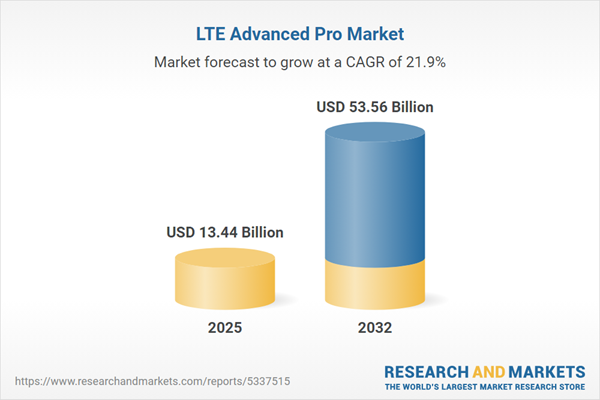Speak directly to the analyst to clarify any post sales queries you may have.
The LTE Advanced Pro market delivers adaptive wireless connectivity solutions to help senior decision-makers modernize operations, enhance resilience, and transition smoothly through digital transformation. Enterprise buyers benefit from LTE Advanced Pro by aligning network infrastructure with evolving business demands and compliance expectations.
Market Snapshot: LTE Advanced Pro Market Size and Growth
The LTE Advanced Pro market demonstrated robust growth from 2024 to 2025, increasing from USD 11 billion to USD 13.44 billion, reflecting a compound annual growth rate (CAGR) of 21.87%. Forecasts indicate continued expansion to USD 53.56 billion by 2032. Drivers include strong enterprise investment in upgrading wireless infrastructure, innovative approaches to spectrum management, and a rapid surge in IoT adoption. Companies are leveraging LTE Advanced Pro to achieve flexible, reliable network performance and to support key business transformation strategies, especially as ecosystem complexity accelerates across industries.
Scope & Segmentation of the LTE Advanced Pro Market
- Device Types: Enterprise routers, IoT-optimized hardware, standard mobile devices, and LTE-M or NB-IoT units (including Cat M1, Cat M2, Cat NB1, Cat NB2) cater to the diverse connectivity requirements spanning both industrial and consumer applications. These devices enable organizations to support seamless data transfers across dispersed locations and asset fleets.
- Component Types: Discrete chipsets, integrated chipsets, plug-in modules, and surface-mount modules offer scalable, modular options for infrastructure expansion. This versatility allows enterprises to efficiently progress from initial pilot implementations through to comprehensive deployment across multiple sites.
- Deployment Modes: Macro cell, small cell, femto cell, micro cell, and pico cell architectures address requirements for urban, industrial, and remote environments, supporting agile business operations across diverse geographies and use cases.
- Applications: Enterprise broadband solutions offer high-speed data connectivity, secure Voice over LTE ensures stable and private communication, and machine-to-machine connections facilitate critical operational workflows. These features are foundational in sectors such as public safety, healthcare, and logistics, where efficiency and reliability are critical.
- Geographic Regions: The Americas, Europe, Middle East and Africa, and Asia-Pacific represent core markets that exhibit distinctive adoption trends, technological maturity, and regulatory environments. Leveraging local infrastructure strengths, organizations can refine market entry and compliance strategies per region.
- Key Companies: Prominent technology providers including Huawei Technologies, Ericsson, Nokia, ZTE, Samsung Electronics, Cisco Systems, NEC Corporation, Fujitsu Limited, Ciena Corporation, Juniper Networks, and a range of system integrators play significant roles in advancing global deployment. Their efforts enable streamlined network integration for enterprises seeking multi-region consistency and scale.
Key Takeaways for Senior Decision-Makers
- LTE Advanced Pro offers organizations the ability to rapidly update operational and digital workflows, ensuring adaptability to changing customer and regulatory expectations.
- Enhanced spectrum management and carrier aggregation features help enterprises proactively address new industry standards and support diverse business models.
- Integrated automation and robust machine-to-machine networking empower secure digital transformation efforts, supporting continuous compliance with evolving security mandates.
- Collaborations between technology vendors, system integrators, and regulatory groups help reduce deployment risks, ensuring smoother rollouts in both established and emerging markets.
- By adopting effective supply chain management practices, organizations can address unforeseen disruptions and accelerate the rollout of advanced wireless solutions.
Tariff Impact and Supply Chain Considerations
- Recent U.S. tariffs on semiconductor imports motivate manufacturers to diversify supply networks, expand production within Southeast Asia, and consider near-shoring to mitigate geopolitical exposure.
- Telecom and procurement teams are evolving inventory strategies in light of shifting regulatory demands, preserving reliable access to LTE Advanced Pro hardware for critical projects.
- Ongoing collaboration with regulators and customs authorities is reducing delivery delays and enhancing dependability for complex, large-scale network rollouts.
Methodology & Data Sources
Analysis is based on interviews with industry leaders, comprehensive secondary research, patent reviews, and guidance from expert panels. This multi-source approach provides insight into market segmentation, technology evolution, and the importance of resilient supply chains in LTE Advanced Pro adoption.
Why This Report Matters
- The report equips leadership with actionable strategies for optimizing wireless connectivity in rapidly evolving technology and compliance environments.
- Detailed analysis of regional regulatory considerations supports more predictable project execution and effective risk mitigation for cross-border and industry-specific initiatives.
- By using benchmark insights, senior decision-makers can facilitate future-ready wireless integration across their organizations.
Conclusion
Enterprises selecting LTE Advanced Pro are better positioned to adapt as digital ecosystems evolve, overcome operational challenges with confidence, and maintain strong business continuity for the future.
Additional Product Information:
- Purchase of this report includes 1 year online access with quarterly updates.
- This report can be updated on request. Please contact our Customer Experience team using the Ask a Question widget on our website.
Table of Contents
3. Executive Summary
4. Market Overview
7. Cumulative Impact of Artificial Intelligence 2025
Companies Mentioned
The companies profiled in this LTE Advanced Pro market report include:- Huawei Technologies Co., Ltd.
- Telefonaktiebolaget LM Ericsson
- Nokia Corporation
- ZTE Corporation
- Samsung Electronics Co., Ltd.
- Cisco Systems, Inc.
- NEC Corporation
- Fujitsu Limited
- Ciena Corporation
- Juniper Networks, Inc.
Table Information
| Report Attribute | Details |
|---|---|
| No. of Pages | 198 |
| Published | October 2025 |
| Forecast Period | 2025 - 2032 |
| Estimated Market Value ( USD | $ 13.44 Billion |
| Forecasted Market Value ( USD | $ 53.56 Billion |
| Compound Annual Growth Rate | 21.8% |
| Regions Covered | Global |
| No. of Companies Mentioned | 11 |









